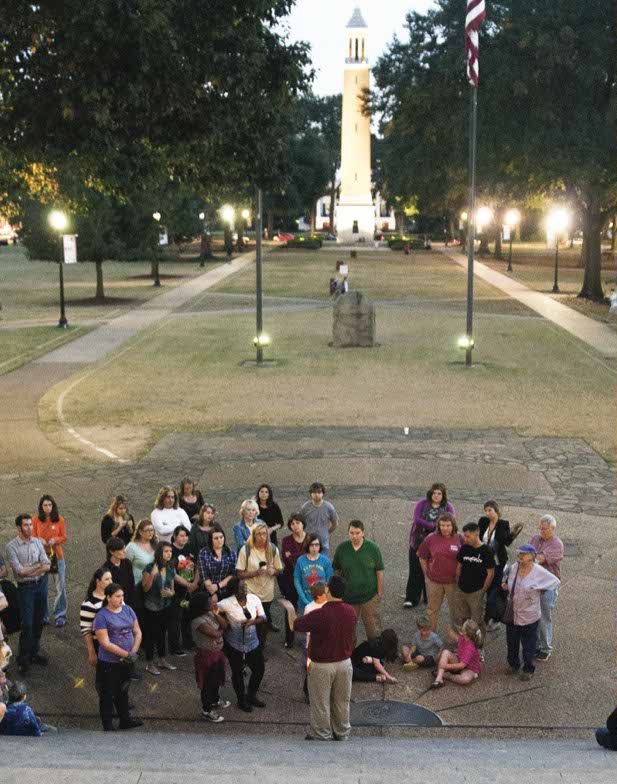As children in ghoul costumes hold their parents’ hands and University of Alabama students glance sidelong at the sites by Gorgas Library they thought they knew so well, Todd Hester, a naturalist for the Alabama Museum of Natural History, holds a ?ickering lantern out to his audience. It lights ruins of what little is left on campus after most was burned by Union solders in 1865, a few days before the Civil War was over. Hester tells stories that have been known to spook the campus over the years.
“They can make their own decision on whether or not it’s real,” said Hester, who has manned the Haunting at the Museum tour alone for the last two years.
On Tuesday night from 6-8 p.m., three 30-minute candlelit tours of campus landmarks with ghost stories began at Smith Hall and rounded the Quad, ending between Gorgas Library and the Gorgas House. The free event for all ages was sponsored by the University’s Museum of Natural History in order to give UA students, alumni and Tuscaloosa community members the opportunity to learn the history and a few of the haunted tales ?oating around the Quad.
More than 300 people attended the event’s third year of tours. A decorated Smith Hall offered punch and Halloween-themed treats inside for people while they scoped out the museum’s well-preserved historical landmarks and, potentially, ghosts.
“I’ve had no personal encounters, but I really love a good story,” said Allie Sorlie, education outreach coordinator for the Alabama Museum of Natural History. “Let me tell you though, Todd really knows how to tell one.”
Smith Hall was named after and formerly owned by geologist Eugene Allan Smith, who some believe still haunts the museum. Hester said former employees and students have claimed they’ve heard footsteps shuf?ing through the building when no one else was there.
“People that would come into tours would always want to know if it was haunted, so we decided to do a Haunting at the Museum,” Hester said.
For this year’s tour, Hester chose to begin by throwing in an additional story that hasn’t been told in previous years. Three velvet ropes close off Smith’s old of?ce, preserving it for visitors to see. Hester said one night, before they closed, one of the velvet ropes was swaying back and forth, while the other two were not. He dismissed it as shaky ?oors, but there wasn’t any nearby construction. He said the single rope kept swinging without reason for longer than an hour.
“Eventually, I had to just reach over and stop it myself,” Hester said.
That was one of the more recent hauntings, taking place only about three years ago. Most of Hester’s stories date much further back, to around the time of the Civil War. He led the tour to the fenced steps of the ruined Madison Hall, which was burned down by Union troops attacking Confederate buildings in 1865. According to Hester’s story, people can smell smoke in the air around the steps on April 3, the day the building was burned.
“I believe in ghosts, but I hope it’s all fun and games here,” Shelby Bishop, a sophomore majoring in secondary education, said.
After leading the tour group to the steps of Gorgas Library, the Mound and the Little Round House on the side of Gorgas, Hester continued with stories dating back to the burning of most of the area on campus in 1865. The next Haunting at the Museum tour will take place during next year’s Halloween.
“If you aren’t one for scary stuff, I warn you to stay in the sunlight,” Hester said.







